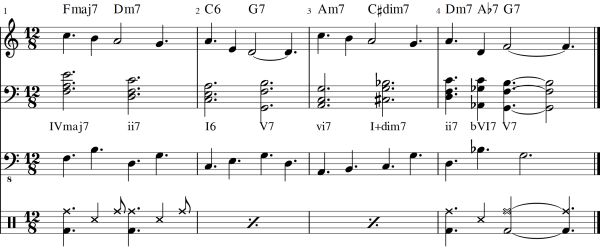Audio: jazz voicing (0:12)

jazz voicing plays jazz chords in different voicings in the key of C by a jazz trio comprising piano, double bass and drums. The jazz voicing figure shows the score:
Jazz voicing is the arrangement of the notes in a jazz chord in order of pitch.
Jazz voicing can be considered a performance issue or a composition issue. For jazz performance, all that is required from the jazz writer is a chord progression, together with an optional melody, in lead sheet format. For jazz composition, all that needs to be done is to follow the rules for jazz voicing, of which, thankfully, there are none. A chord can be voiced in close or open harmony, in root position or inverted. There is no restriction on voicing, largely due to the large number of possible permutations.
A chord can be voiced complete or incomplete. An incomplete chord is common. An incomplete seventh chord includes the root note and the intervals of third and seventh above the root. The interval of a fifth above the root is omitted. All that is left are three notes: the root, the third above, and the seventh above. These three notes constitute what are called guide notes or guide tones. The thinking behind this is that three notes are enough to define a seventh chord. The interval of a seventh above the root identifies the chord as a seventh chord, the interval of a third above the root defines the quality of the chord, whether it is major or minor. When the fifth is an important factor, such as in the augmented major seventh chord, then the chord can be written complete.
Drop voicing is sometimes used in jazz harmony. It refers to the process of dropping, lowering, the pitch of a chord note by an octave. The chord is assumed to be in close harmony and the notes in the chord are numbered from the top pitch down, not the bottom pitch up. It does not matter whether the chord is in root position or inverted, numbering starts with the top pitch and works down. The top pitch, the soprano note, is note 1. It is usually the melody and rarely dropped. Drop 2 voicing takes the number 2 note, the second highest pitched note, and lowers it an octave. Drop 3 voicing does the same with the number 3 note and drop 4 voicing with the number 4 note. For example, the G7 dominant seventh in root position in close harmony is GBDF reading left to right up in pitch, or FDBG reading from left to right but this time down in pitch. In drop 2 voicing it is FBGD, reading from left to right down in pitch, the second note, D, having dropped an octave. Drop voicing always converts a close harmony chord into an open harmony chord and increases the space between the notes. The G7 chord in bar two of jazz voicing can be thought of as a third inversion chord in drop 3 voicing.
Multipart parallel harmony is popular in jazz harmony, where it is known as planing. It occurs in the bVI7-V7 progression that ends jazz voicing. One consequence of planing is parallel fifths, and these are allowed in jazz harmony, which demonstrates another difference between it and functional harmony. You may use parallel octaves too, although some jazz commentators frown on their use.